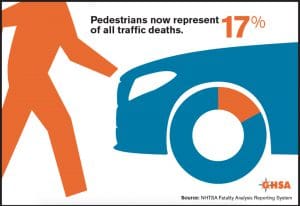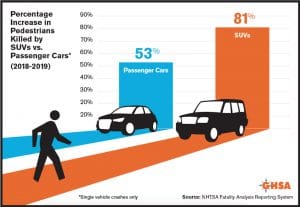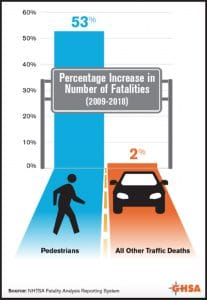
Pedestrian deaths in the U.S. rose again in 2019, in contrast to overall traffic fatalities, which fell 2%.
The number of people killed in motor vehicle incidents last year dipped for the second year in a row – but that trend was countered by a rise in pedestrian fatalities, new data reveals.
An estimated 6,590 people were killed were killed on or alongside U.S. roadways in 2019, according to a new report from the Governors Highway Safety Association, or GHSA. If the final numbers hold, that would mark the highest death tally of pedestrians since 1998.
“Following 30 years of declining pedestrian fatalities, there has been a complete reversal of progress,” report author Richard Retting said in a news release. “Pedestrians are at an inherent disadvantage in collisions, and we must continue to take a broad approach to pedestrian safety.”
(U.S. highway deaths declined in 2019.)
The good news came with numbers released by the National Safety Council, or NSC, last week showing that overall highway fatalities dropped 2% in 2019, the second consecutive annual decline – though with a total of 38,800 Americans dying in crashes, the nonprofit group said the number of deaths was “still unacceptable.”

Officials believe the rise in SUV and truck sales have contributed, in part, to the rise in pedestrian deaths.
Highway deaths of all forms surged during the past decade, experts still struggling to get a handle on why. Among other things, traffic on U.S. roads as the economy recovered from the Great Recession has now hit record levels. Distracted and impaired driving also came in for blame.
Those potential causes likely contributed to the rise in pedestrian deaths, in particular. But, in some situations, safety analysts say there may be some unique factors playing a role.
Among other things, there is the ongoing shift from traditional passenger cars to light trucks – especially the utility vehicles that last year accounted for fully 52% of U.S. new vehicle sales. The National Highway Traffic Safety Administration began noticing a cause-and-effect relationship as early as 2015, a study released that year stating that “pedestrians are two to three times more likely to suffer a fatality when struck by an SUV or pickup than when struck by a passenger car.”
A separate NHTSA study found young children as much as four times more likely to be killed when struck by a light truck than in an incident involving a passenger car, noted the Detroit Free Press.
(U.S. Traffic Deaths Drop 2.4% in 2018.)
Not only are so-called ”light trucks” heavier than sedans and coupes, but they also tend to have taller, blunter grilles which make it more likely a pedestrian will take the full force of an impact or even be knocked underneath the vehicle.
In its report on highway fatalities, the NSC made several recommendations aimed at reducing all types of highway deaths. That included more aggressive enforcement of laws on impaired driving and distracted driving – the latter estimated to be responsible for as many as one in 10 roadway fatalities.
Experts also have called on local and state governments to take steps to redesign roadways, especially those where clusters of pedestrian fatalities have been reported.
During the past decade, New York City, which has an unusually high amount of pedestrian traffic, even factoring in its overall population, began addressing issues like lane markings, pedestrian crossing locations and traffic signaling devices. By 2017, the effort began paying off as fatalities in the Big Apple started declining to levels not seen since the city started tracking fatalities in 1910.
“In the past 10 years, the number of pedestrian fatalities on our nation’s roadways has increased by more than 50%,” GHSA Executive Director Jonathan Adkins said in the release. “This alarming trend signifies that we need to consider all the factors involved in this rise, identify the high-risk areas, allocate resources where they’re needed most, and continue to work with local law enforcement partners to address the chronic driver violations that contribute to pedestrian crashes.”
The U.S. isn’t the only country faced with the problem. But some have directly tried to come up with solutions on the vehicle side. Europe, for example, requires manufacturers to design in ways to reduce the impact forces when a pedestrian is struck. These can include passive “crumple zones,” such as a gap between the hood and the engine underneath, or even external airbags and other active energy absorption systems.
(Exterior Airbags Could Save Lives of Passengers and Pedestrians.)
While NHTSA has not adopted that approach in the U.S., automakers have been moving forward with the adoption of systems that can detect pedestrians at risk of being struck, sounding an alert for the driver. In some cases, the new systems – which can rely on radar, laser or camera sensors – are capable of stopping the vehicle automatically should the driver not respond.

